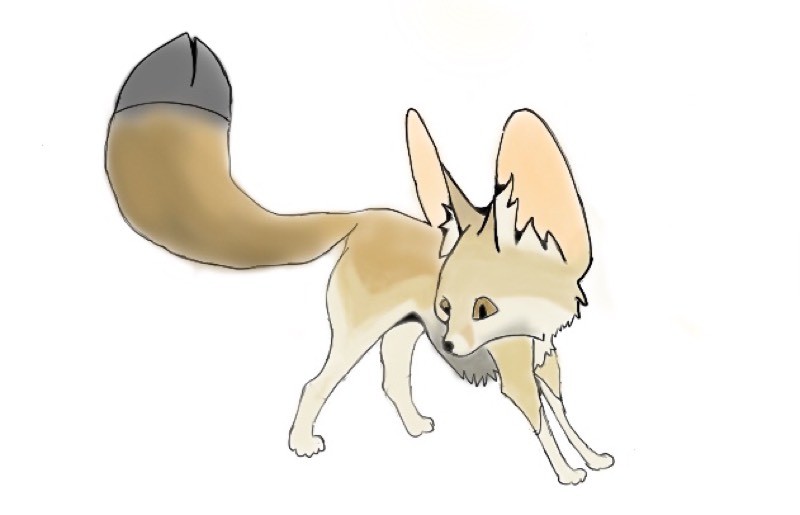- Fennec Fox, drawing and essay by Daniel Xu
CLASSIFICATION
The fennec fox (Vulpes zerda) is the smallest type of fox – and yet – proportionally it has the biggest ears! It’s almost as if it wants to fly away, above the desert floor, using its ears as wings! The giant ears also help reduce heat. The fennec fox’s name comes from fanak, meaning ‘fox’ in Berber (the language of the indigenous people of North Africa), and the name of the species, zerda, is from the word xeros which means ‘dry’ in the Greek language, because the fox’s habitat is dry.
The Sahara Desert is huge, and jumps borders: it stretches over North Africa, is what the Sinai Peninsula (a big triangle on the right of North Africa) is made of, and stretches until it becomes the Arabian Desert (which looks like a winter boot) to the east of the Sinai Peninsula. This is where fennec foxes trot and hunt, sleep and eat.

Before, fennec foxes were in the genus Fennecus: its own genus, but now fennec foxes have been reclassified into genus Vulpes, with lots of other types of foxes. Scientists found out that there are basic and usual features of foxes, but there are also lots of differences in the fennec fox, that make them special from other foxes, with physical traits and social personality (the way they interact) among them.
The fennec foxes’ fur, hearing, and kidney structure have modified to allow them to thrive in tremendously high-temperatures, and to deal with a lack of water in the desert environments.
The fennec’s hearing is delicate enough to listen to prey moving under the ground. It mostly eats insects, small mammals, and birds. The fennec fox has a lifespan of 14 years. Its predators are especially the African species of eagle owls, other predators are caracals, jackals, striped hyenas, and the saluki, (a domestic dog that looks like a greyhound that’s local to the area.)

But fennec foxes are very challenging to catch. Families of fennec foxes make dens by digging in the sand for habitation and protection. The dens are about as large as 120 m2 or 1,292 sq ft, and they even share dens with other families. Exact population is unknown to us humans, but because of the estimated population from the ratio of sights and territory, scientists predict that fennec foxes are presently not vulnerable because of extinction.

TRAITS
Information known about the fennec fox’s social traits is not comprehensive: the knowledge of these animals are restricted to captive fennec foxes. The fennec foxes’ fur is popular among the native peoples of North Africa, and in some other parts of the globe. The fennec is also bred as an exotic house pet (meaning it’s a wild pet).

Breeders prefer removing young kits from the mother, because owners enjoy more handleable foxes, making them more expensive. The fennec fox weighs about 1.5–3.5 lb, with a body length of between 24–41 cm; it is around 20.3 cm tall. The tail has a black colored tip and it is 18–31 cm long, and the ears may be from 10 to 15 cm long. The furry coat is always a creamy color and also fluffy, which reduces heat in the daytime and makes the fennec warm at nighttime. The fennec fox is the nation-wide creature of Algeria.



Thank you, Melody! I’m just in this file to remove an image (requested by the nature photographer, it is the image of the owl flying, wings totally vertical). Thanks for reading – there are plenty more recently-published essays on animals – the latest is the Honey Badger.